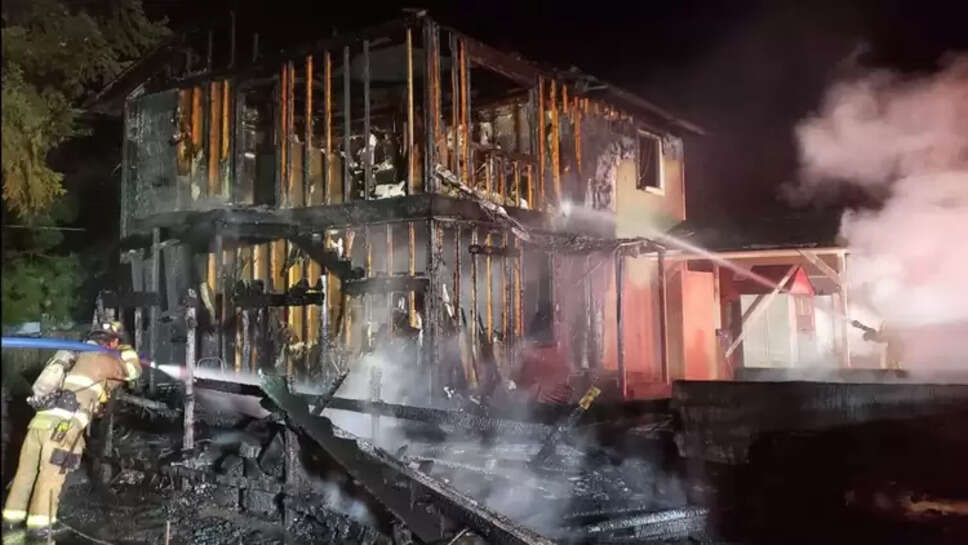Chaos on Canfield Mountain: Firefighters Ambushed, 2 Dead, Others Injured in Idaho Siege

In a shocking and violent turn of events in the usually quiet forests of northern Idaho, at least two firefighters were killed and several others injured when they were ambushed by a sniper while responding to a wildfire. The incident, which unfolded near Canfield Mountain outside Coeur d’Alene, has left the community shaken and first responder agencies across the nation on high alert.
What began as a routine call to extinguish a wildfire quickly turned into a deadly trap, as shots rang out shortly after the first crews arrived at the scene. Authorities believe the fire may have been deliberately set to lure emergency personnel into a premeditated ambush, where they were met with high-powered gunfire from a concealed shooter.
A Routine Response Turns Deadly
Firefighters arrived on the mountainside just after noon, responding to reports of a rapidly spreading brush fire in a dry, wooded area prone to seasonal wildfires. Within 30 minutes of setting up operations, the team came under unexpected gunfire. Multiple shots echoed through the canyon, catching responders completely off-guard.
Two firefighters were fatally struck in the initial moments of the attack, and several others scrambled for cover as the sound of gunfire intensified. One firefighter was critically wounded and transported to a nearby hospital for emergency surgery. Others suffered minor injuries, including from falling or debris during the chaos.
Emergency calls flooded into local dispatchers, and law enforcement quickly launched a full-scale response.
Law Enforcement Mobilizes
Within the hour, local police, SWAT teams, and federal law enforcement agencies arrived at the scene and began returning fire toward the sniper’s last known location. Tactical teams used armored vehicles and aerial surveillance to try to pinpoint the shooter, who was believed to be operating from an elevated, forested ridge overlooking the scene.
A shelter-in-place order was issued for nearby communities, including hikers and residents living along the forest's edge. Roads were blocked off, and airspace over the area was restricted. For hours, the operation continued as officers attempted to locate and neutralize the threat.
Eventually, the suspect was found dead in the wooded area near the origin point of the attack, with a firearm recovered nearby. Authorities are still investigating whether the shooter was killed in the exchange with police or died by suicide.
A Premeditated Attack?
Preliminary evidence suggests the fire may have been intentionally set to draw emergency responders to the area. Investigators found signs of accelerants near the fire’s origin point, and the shooter had set up in a concealed vantage point, likely chosen in advance.
This tactic mirrors other rare but devastating ambushes seen in the past, where attackers deliberately start fires or create emergencies to target first responders. It represents a disturbing evolution in violent attacks, targeting individuals who risk their lives to protect communities.
Law enforcement has not yet confirmed a motive, but officials stated that the planning involved suggests the attack was not random. The shooter’s identity has not been publicly released as authorities notify next of kin and investigate possible affiliations or prior warnings.
Community in Mourning
As news of the ambush spread, an outpouring of grief and support flowed in from across the country. Tributes to the fallen firefighters appeared outside local fire stations, with flags lowered to half-staff and fellow firefighters standing vigil in uniform.
Family members and colleagues described the victims as dedicated professionals who loved their work and had always stepped forward in times of crisis. Both had served in the department for several years and were described as role models to younger recruits.
The injured firefighter remains hospitalized in serious condition, and others who were present at the scene are receiving trauma counseling and mental health support. Fire departments in nearby counties offered assistance and relief staff to allow affected crews time to recover.
Political and National Response
State leaders and federal officials quickly condemned the attack. The governor called it a “cowardly act of targeted violence” and vowed to ensure justice for those killed. National firefighter unions and first responder advocacy groups also issued statements of support, highlighting the growing dangers faced by emergency personnel even in seemingly routine situations.
Calls have grown for increased safety protocols, including security escorts for firefighters responding to incidents in isolated or high-risk areas. In the wake of the attack, several fire departments across the region reviewed their protocols and temporarily paused operations in similar terrains until the threat level could be fully assessed.
Fire Still Burning
Amid the chaos, the wildfire that prompted the original emergency call continued to burn. With the firefighting effort disrupted, the fire spread through the brush, threatening to reach nearby homes and recreational areas. Once the sniper threat was neutralized, firefighting efforts resumed under heavy law enforcement protection.
Helicopters and aerial tankers were deployed to contain the blaze from above while ground crews, operating in pairs and under surveillance, resumed direct suppression. The fire was eventually brought under control, but not before damaging several acres of protected forestland.
Reflection and Warning
The ambush in Idaho serves as a sobering reminder that even those dedicated to saving lives are not immune from the threat of violence. The deliberate targeting of firefighters marks a new and alarming trend in domestic threats and has sparked urgent discussions across fire and police departments nationwide.
While rare, such incidents have devastating ripple effects—forcing a reevaluation of what used to be routine and highlighting the need for greater interagency coordination, situational awareness, and mental health support for responders in the aftermath.
The tragedy leaves behind unanswered questions about the shooter’s motives, but one thing is clear: the fallen firefighters died in the line of duty, doing what they were trained and committed to do—protect their community.
.jpg)